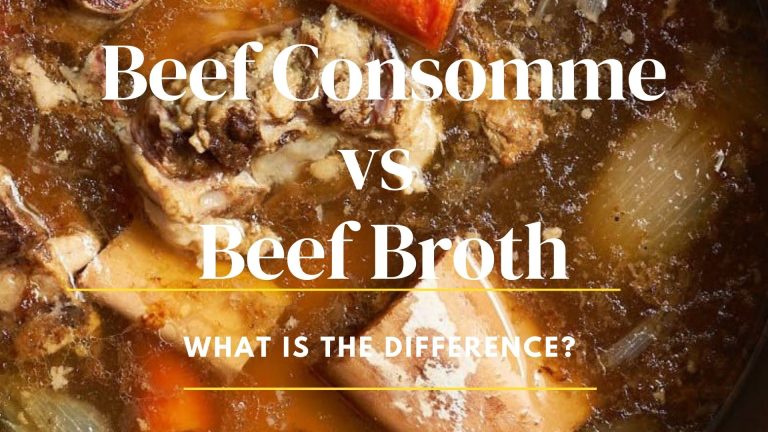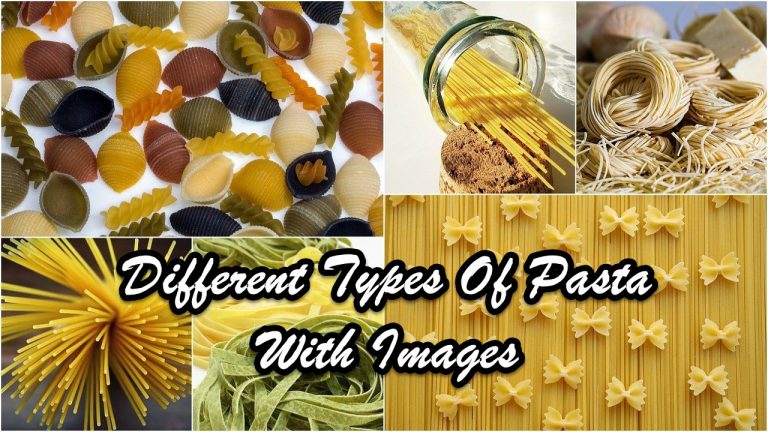18 Different Types Of Cauliflower With Images
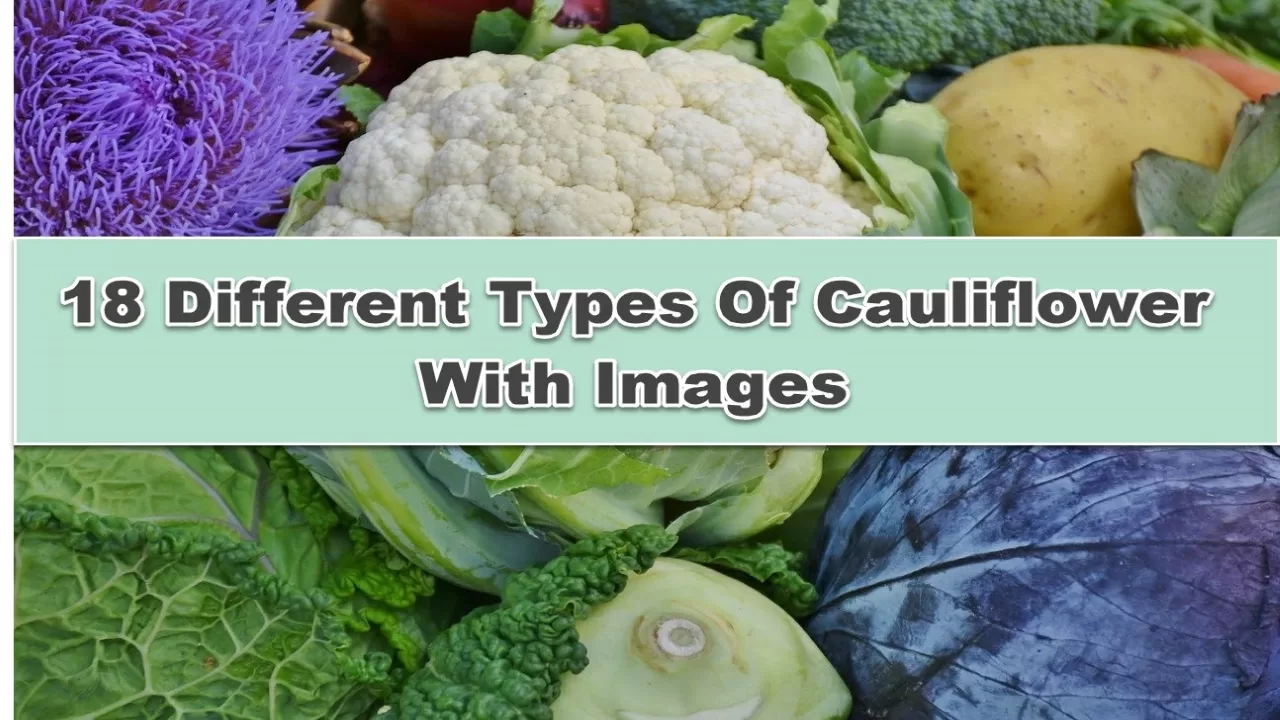
A lot of us are familiar with the typical white cauliflower. However, did you know that there are different types of cauliflower? Some, if not most, can rarely be seen in the market today.
If you wish to learn more, you will surely be glad to read the rest of this blog. You’ll discover the different varieties of cauliflower, their general description, health benefits, and other interesting facts.
What’s more, we include cauliflower images, so you can easily get a mental picture of them.
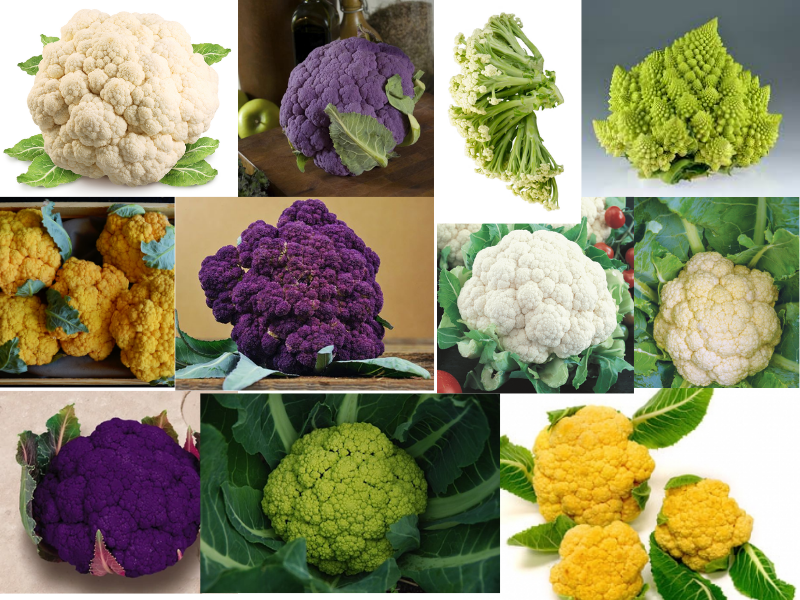
What Is Cauliflower?
Cauliflower is a type of vegetable that belongs to the species Brassica oleracea. If you think that cauliflowers look like broccoli, you’re right. Cauliflowers and broccoli are part of the same species, which also include Brussels sprouts, collard greens, cabbage, and kale.
While cauliflower is usually white, some come in various shades of purple, orange, and green. The taste of cauliflower is usually slightly sweet, mild, and a little nutty.
The cauliflower is true to its name and it is technically a flower. While it is not obvious, the heads of cauliflower are composed of tightly packed flower buds, often referred to as curds. The flowers, leaves, and stems are edible, too.
What is the nutritional value of cauliflower?
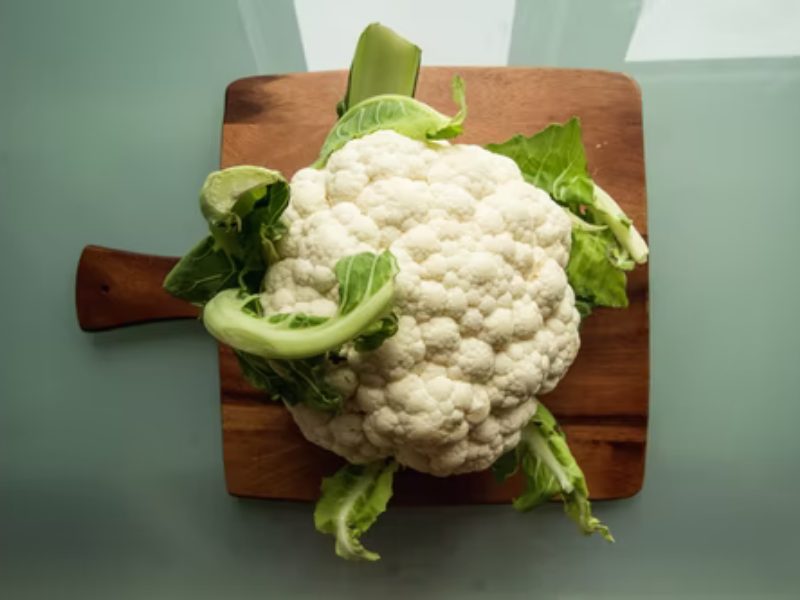
As a cruciferous vegetable, cauliflower is rich in vitamins and minerals. Here are a few of the best health benefits of cauliflower:
- Vitamin C for improving immunity
- Vitamin K for blood clotting
- Iron for growth and development
- Calcium for strengthening the bone
- Potassium helps in muscle contraction and nerve functions
- Magnesium supports energy production
Now that you know what cauliflower is and its health benefits, here are now the most common types of cauliflower.
Common Types of Cauliflower
Before we go to the specific varieties of cauliflower, let’s see how they are categorized by region:
- Asian varieties – these are the types of cauliflower that thrive in warmer weather.
- Northern European varieties – cauliflower that is ready for harvest early in the spring season.
- Northwest European varieties – cauliflower that is usually harvested in the fall.
- Italian varieties – include the original cauliflower species that include colored ones and Romanesco type.
Let’s now take a look at the specific types of cauliflower that include pictures.
Types Of Cauliflower

White cauliflower
As the most common type of cauliflower, let’s talk about white cauliflower first.
White cauliflower, as its name suggests, has a white head of flower buds, which is also known as curd. The flower buds are surrounded by green leaves.
It’s worth noting that white cauliflower is a general term used to refer to those cauliflowers with white color. There are various types of white cauliflower as well. These are the following:
- Snow spring cauliflower – comes with a crispy and firm white curd.
- Early white cauliflower – this cauliflower grows faster than other types of white cauliflower.
- Snowball cauliflower – comes in medium size and is widely available in North America.
- Cornish cauliflower – found in the Cornwall area of England and is considered to be one of the oldest cultivars of cauliflower.
- White corona – this one is a smaller variety of cauliflower.
- Attribute cauliflower hybrid – as a hybrid variety, it is larger than most cauliflower and can grow faster as well.
We will discuss some of these more as we go along.
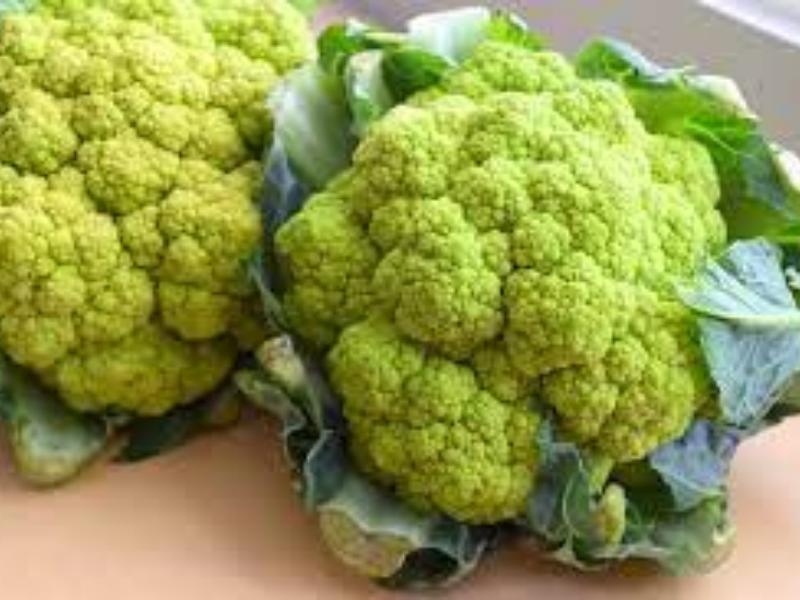
Green Cauliflower
As you may already know, cauliflowers look like broccoli, but the main difference is their color. However, with green cauliflower, you can easily confuse the two. That’s why green cauliflower is also called broccoflower.
Description
Green cauliflower looks exactly like the typical white cauliflower but with obvious differences in their color. Aside from the color, green cauliflower differs from white cauliflower in its taste.
For example, green cauliflowers are said to have a milder and sweeter taste. So, if you or your little ones don’t like white cauliflowers, give the green variety a try.
Another difference you might want to note is the texture. Green cauliflowers are more fibrous. White cauliflowers, on the other hand, have a crumbly taste. This makes white cauliflowers to be the more preferred option if you’re preparing cauliflower rice.

Yellow Cauliflower
Description
Yellow cauliflowers can also look orange in color. You can choose yellow cauliflowers if you want to make your food more presentable, unique, and of course, colorful. The reason is that yellow cauliflowers generally don’t lose their hue even after cooking.
Compared to its white counterparts, yellow cauliflowers are healthier. Some studies concluded that yellow/orange cauliflowers possess 25 times more vitamin A compared to white cauliflowers.
Because of its color, yellow cauliflowers are also called the “cheddar” cauliflower. Nevertheless, it doesn’t taste like cheddar cheese at all. It is sweeter though compared to white cauliflower.
There are two common varieties of yellow cauliflower. First is the cheddar cauliflower which is the more popular variety. It has a medium-sized head. The second variety is the flame star hybrid. It is also medium in size but it has a smoother texture with firm and dense curds. We will talk more about the flame star hybrid later.

Purple cauliflower
Ever heard of a purple cauliflower? Most people haven’t, but yes, purple cauliflower does exist.
What’s more interesting about purple cauliflower is that it is among the most nutritious types of vegetable. Any purple vegetable is known to be a healthier choice.
The purple color of the cauliflower indicates a high level of antioxidants known as anthocyanin. Antioxidants are known to decrease your chance of getting cardiovascular and cancer diseases. It also reduces inflammation.
Aside from a high level of antioxidants, purple cauliflowers also have vitamins, minerals, and nutrients you’ll find in the common cauliflower.
Description
The most striking characteristic of purple cauliflower is its color. Its leaves are even unique as they appear bluish-green.
In terms of its taste, the purple cauliflower won’t disappoint as well. It is sweeter and nuttier compared to white cauliflowers. You can steam, simmer, and roast the purple cauliflower without altering its color. Adding some lemon juice while cooking purple cauliflower can also preserve its beautiful hue.
There are different types of purple cauliflower. These are the following:
- Sicilian Violet – this comes with a lively, deep lilac color.
- Purple of Sicily – a medium-sized, deep purple cauliflower that turns green when cooked.
- Purple Cape – this cauliflower is easy to grow and comes with a large, delicious curd.
- Graffiti hybrid – a sweet cauliflower variety that even after cooking, retains its bright purple color.
- Violet Queen – you can eat both its curds and leaves. Can eat it raw or cooked. Violet Queen can withstand cold temperatures. It has the deepest purple color among its cousins. So deep that it looks dark and black.
- Depurple hybrid – what makes this cauliflower unique is its white stems that further highlight the cauliflower’s purple curd.
We will get to know more about some of these cauliflowers below.

Attribute Hybrid
The attribute hybrid variety has been available for quite a while and looks similar to the typical cauliflower offered in most supermarkets.
It features a smooth, dazzling white head that is around 7 inches in diameter and tall, emerald green leaves that curve for self-blanching and to shield the head.
Description
This kind, which reaches a height of approximately 2 feet, can endure light frost and heat.
It takes 60 to 70 days to mature. This variety has a savory taste with a hint of butteriness and a slightly nutty flavor.
The huge head is ideal for grilling, while the more neutral-flavored curds are ideal to be used in cauliflower rice.
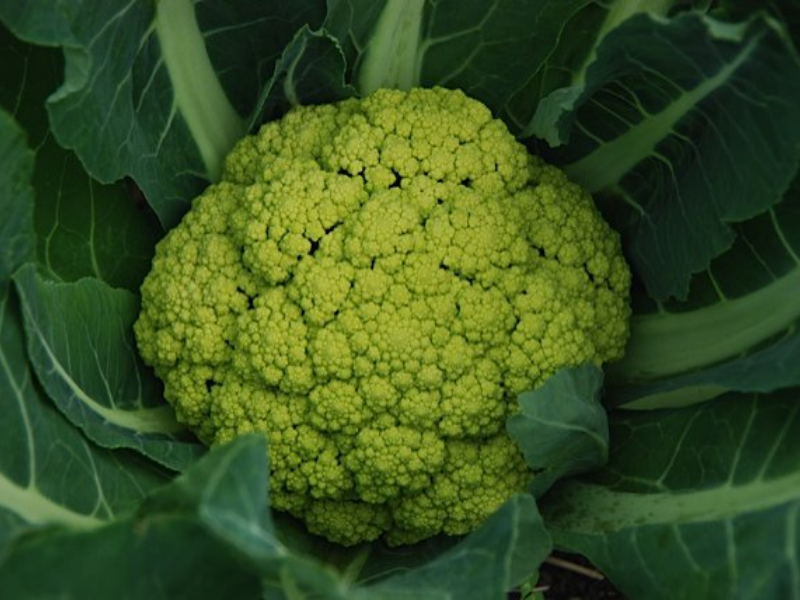
Alverda
The alverda cauliflower is a one-of-a-kind green cauliflower variety that is the most consistent and abundant of its kind.
The medium-sized plants yield a fantastic brilliant lime-green curd, especially when grown in chilly conditions. Its distinctive lime green hue can be enhanced when the head is left unwrapped and exposed to bright sunlight.
These medium-sized heads are ringed with lovely darker green leaves that complement the lighter-colored head.
Description
From planting to harvest, it takes 80-100 days. In the kitchen, alverda cauliflower is delicious even when uncooked and goes well with spicy dishes.
People can use the Alverda cauliflower as a substitute for broccoli in a variety of recipes to provide a different texture but equally delicious flavor.
One tip: use this cauliflower before the head loosens up. It tastes best during this stage.
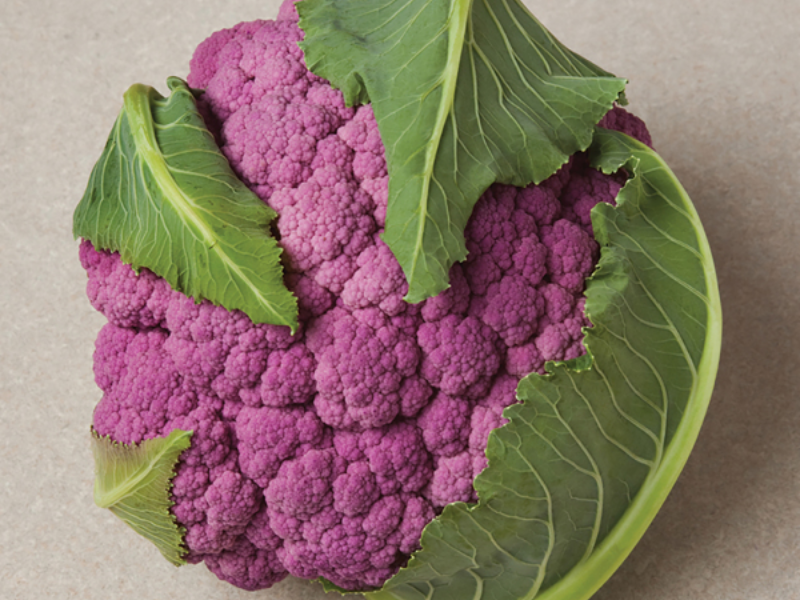
Depurple Hybrid
Depurple hybrid cauliflower adds a bright burst of color to any meal with its deep purple heads and beautiful white stems. This vegetable comes with anthocyanins, which are flavonoids with potent antioxidant properties.
This molecular compound is the same molecule that provides red wine with some of its amazing health advantages.
Because of the anthocyanins content of depurple hybrid cauliflower, it looks dark lavender. Its huge 7-inch head is protected by leaves that are subtle blue to green.
Description
It takes around 80 to 100 days for depurple hybrid cauliflower to fully mature and reaches a height of around 20 inches. It may sound like a long wait, but you’ll discover the wait is all worth it.
To keep color throughout growth, no blanching is necessary. Depurple has a soft texture and a buttery, nutty sweet taste. They may turn green when cooked, but you can use vinegar or lemon juice to maintain their purple color.
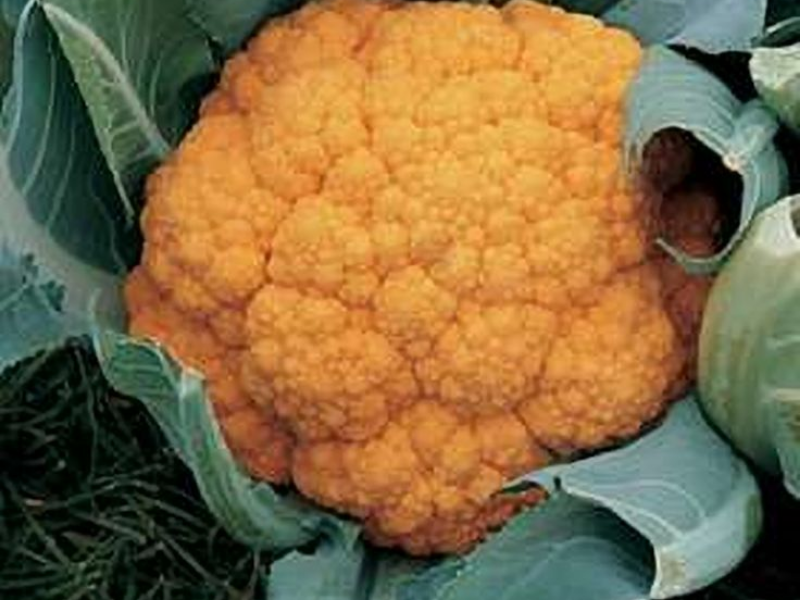
Cheddar Hybrid
Cheddar hybrid cauliflower is a popular alternative for consumers who don’t like the taste of ordinary cauliflower.
Cheddar hybrid has a mild, sweet flavor with a silky texture. It’s a terrific complement to savory recipes that may need a sweet touch.
Description
Because of its beautiful cheddar cheese color that becomes more pronounced during cooking, cheddar hybrid or orange cauliflower is ideal for visually enlivening your dish, especially if you’re serving anything cheesy.
It has a medium to big head and light yellow-green leaves that are short. This orange cauliflower cultivar may grow up to 24 inches tall and it doesn’t need to be blanched to keep its bright and brilliant color.
Cheddar hybrid, like other orange cauliflowers, is rich in beta-carotene and has a high vitamin A content when compared to other varieties. Indeed, this cauliflower variety isn’t just delicious, but also nutritious.
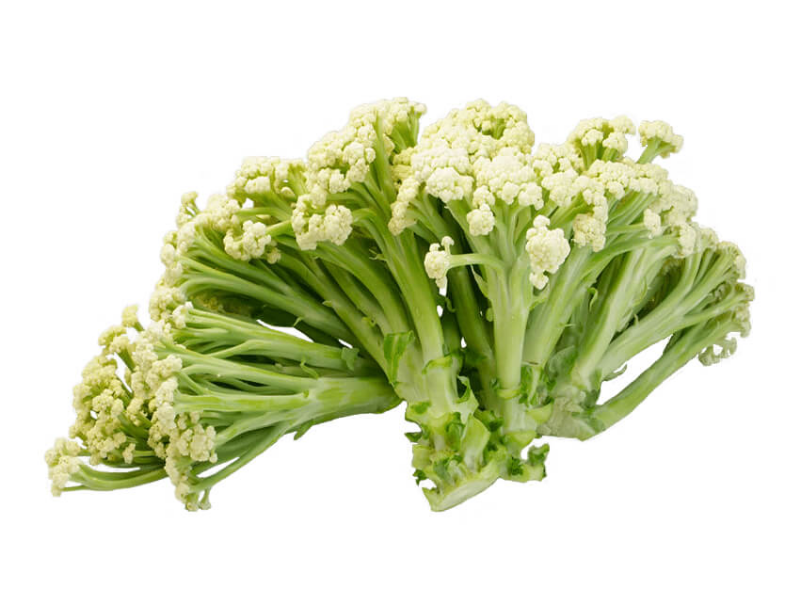
Fioretto Cauliflower
Fioretto, sometimes known as Chinese cauliflower or flowering cauliflower, is a true-breeding cauliflower and broccoli hybrid. It does not look like the usual cauliflower you may know.
However, it is absolutely beautiful that you may even mistake it for a flower. The 5 to 6-inch stems are tall, slender, light green, and have little yellow-white bud clusters at the ends reminiscent of broccoli rabes.
Description
Fioretto cauliflower reaches a height of about 18 inches and is pest-resistant. It has a distinctly sweet, nutty flavor and crunchy texture. This makes people love to have Fioretto cauliflower roasted with garlic, cheese, or spices. You can also add it to Chinese stir-fries.
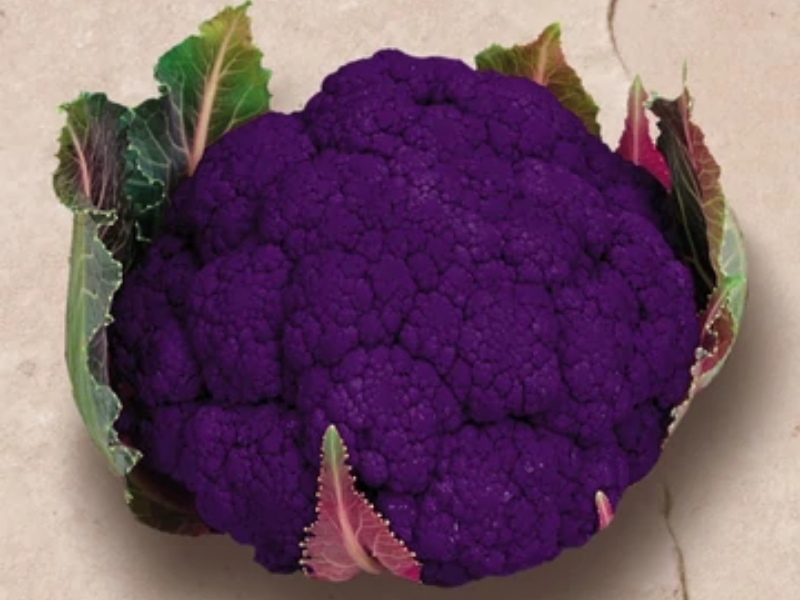
Graffiti Hybrid
One of the most colorful cauliflower kinds is graffiti hybrid cauliflower. The Graffiti Hybrid features a very brilliant plum-colored crown with deep purple hues of thick curds that is 6 to 7 inches in diameter. It has great resistance to moisture and fungal disease and reaches a height of around 24 inches.
Description
The graffiti hybrid’s thick heads have a mildly sweet flavor. They are great steamed, sautéed, or a brief boil, and even when cooked, the florets maintain their vibrant color. They can also be served as raw cauliflower.
Nevertheless, for more intensive cooking, marinate the cauliflower in lemon juice or vinegar first to help maintain those rich colors and more of the healthful anthocyanins which are antioxidants that increase the nutrition in this variety.
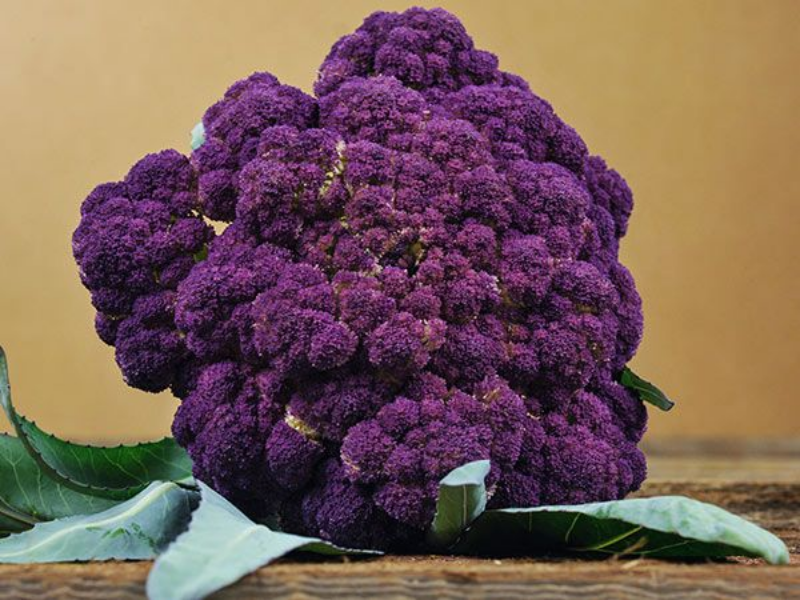
Sicilian Violet
Sicilian Violet, an original European cauliflower variety, is an heirloom type from Italy. It has light green stems and green leaves covering a deep lavender-hued head that measures 6 to 7 inches in diameter and is high in the antioxidant anthocyanin. This insect-resistant cultivar can withstand light cold and grows to a height of 18 to 24 inches.
Description
The Sicilian Violet cauliflower has a mild flavor that complements a variety of flavors. However, it loses its purple hue and turns a deep green color when cooked.
Regardless, it is not necessary to blanch the Sicilian violet. It is more ideal to eat this variety fresh to maintain its beauty and health benefits derived from its antioxidants.
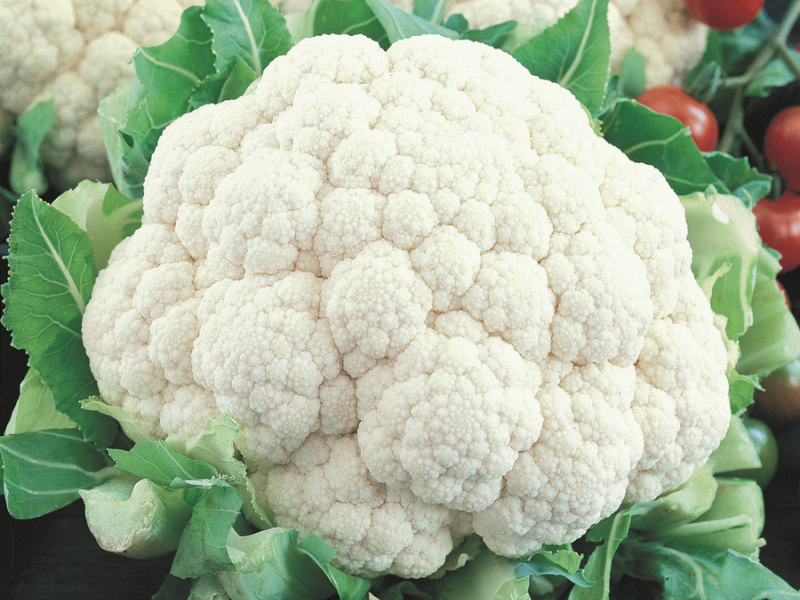
Self-Blanching Snowball
The heirloom cultivar, Self-blanching Snowball, is quite similar to the European original cauliflower forms produced by early civilizations. It has a large 6 to 8-inch wide head shielded by long blue-green leaves that curl over the curds if the temperature is too hot or cold.
Description
This cauliflower type takes 65 to 75 days to mature and grows at a height of up to 30 inches. The cauliflower heads resemble that of a usual white cauliflower.
The self-blanching snowball has the typical store-bought cauliflower taste profile. Its texture and thick florets make this vegetable a great addition to any dish if you want to balance out strong flavors brought about by other ingredients.

Flame Star Hybrid
Flame Star Hybrid is an early orange variety that resembles the cheddar hybrid in appearance and attributes but has a slightly different flavor and is paler in color.
Description
This pastel-orange flame star hybrid has hard heads that only reach a height of around a foot with thick, silky curds that are around 7 inches in diameter. In addition to this, this variety has a higher level of heat tolerance.
When this vegetable is heated, the bright orange color deepens. The flaming star has a buttery, nutty taste that works well in many cuisines. It also has a very sweet flavor and doesn’t require blanching.
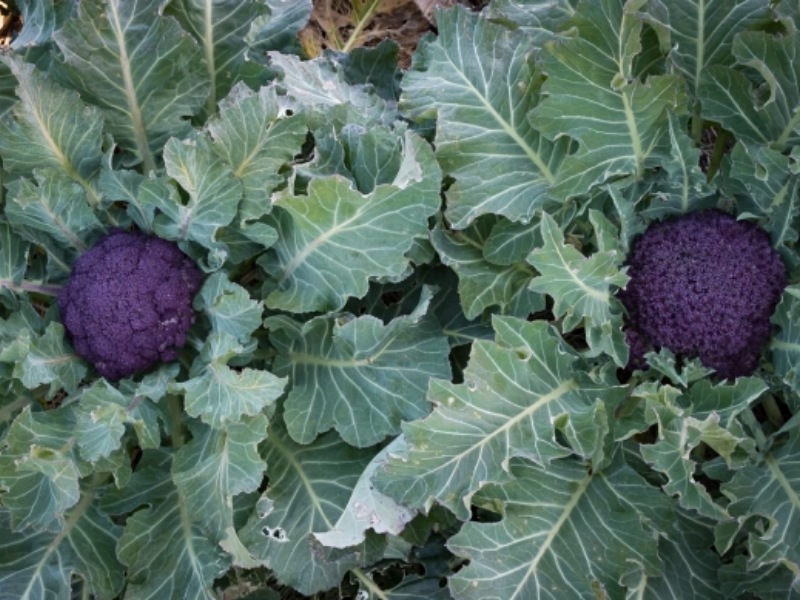
Purple Cape
Purple cape cauliflower is another strikingly beautiful cauliflower variety to add to your purple vegetable collection. The head is a beautiful hue of purple, with light green and lilac leaves flowing up from the sides.
Description
The vibrant purple is accompanied by a sweet flavor that is reminiscent of broccoli and is one of the sweetest types of purple cauliflowers.
This variety is an overwintering cauliflower that forms heads in frigid temperatures. Spring and fall harvests yield the best results. Thus, they are usually planted around and in July. This allows the cauliflower to yield deep purple heads the following February or March.
On top of being delicious, purple capes are also packed with antioxidants, vitamins C and A, and fiber, just like other cauliflowers.
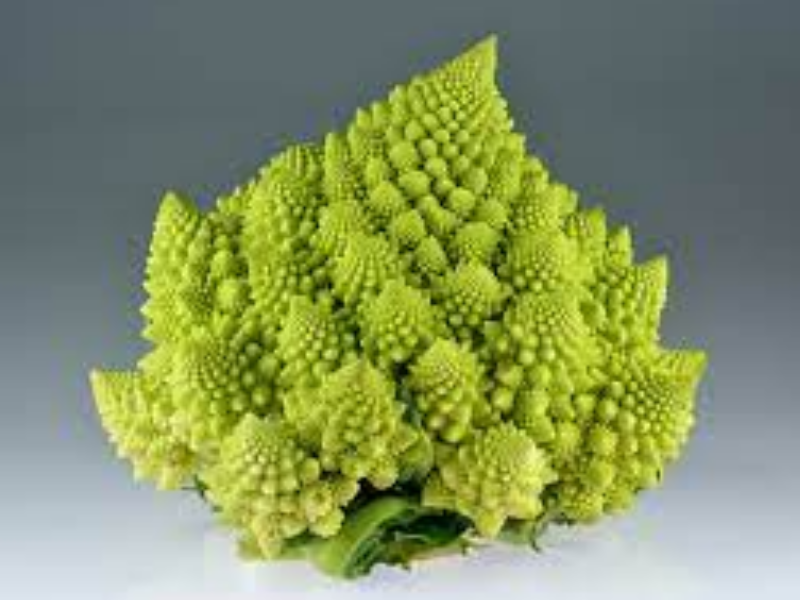
Romanesco Cauliflower
Romanesco cauliflower, also known as the Veronica Romanesco Hybrid, romanesco broccoli, or even broccoflower, has probably the most dramatic appearance out of all the cauliflowers in this list. The romanesco’s spinning, spikey florets that form a fractal pattern makes it look like it came from an alien planet.
Description
Don’t be fooled by the extraterrestrial appearance. Although it looks unusually beautiful, this vegetable has that sweet and savory flavor and a crisp texture like its other cauliflower and broccoli relatives.
It has been bred to have higher-than-average resilience to fungal disease and heat, there is no need of blanching, too. It’s more delicious when cooked with oil and spices, but it may also be used to substitute other forms of cauliflower in meals.
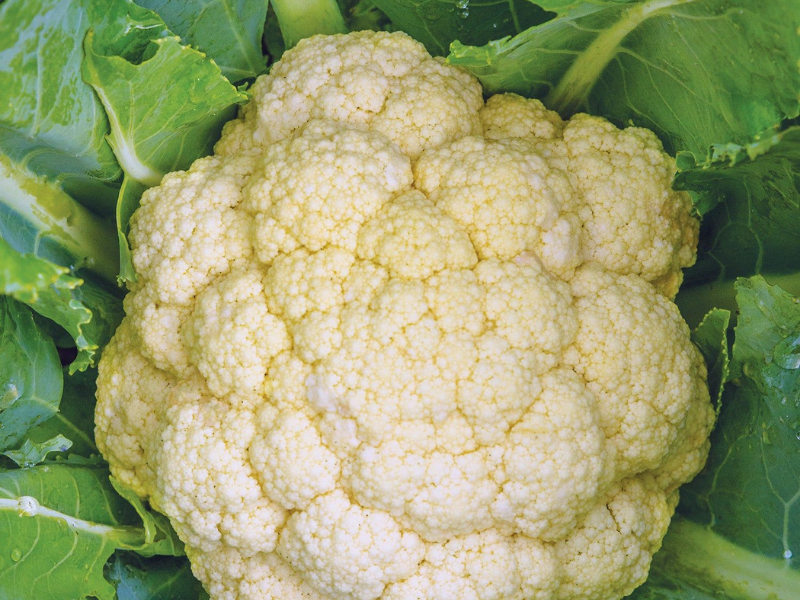
White Corona Hybrid
The white corona hybrid is the cauliflower for you if you want a fast-growing conventional white cauliflower and you have limited space. It can easily thrive in a container or small plot.
Description
The white corona hybrid takes 30 to 33 days to develop. This variety’s thick whitish heads can reach a height of 5 inches and are easy to cultivate in containers.
Plants reach a compact height of 12 to 14 inches and can withstand a mild frost. Its tiny appearance is but a facade though since it’s packed with intense flavors. These florets are buttery and nutty. They pair well with strong dips or sauces.
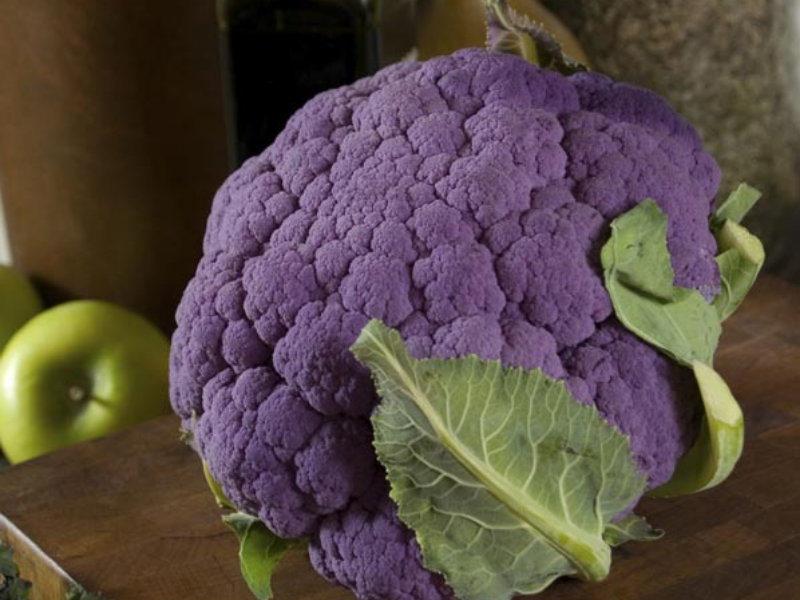
Violet Queen
Violet Queen is a cauliflower cultivar with a color of purple so dark that it can look entirely black with the right lighting condition. It can endure temperatures as low as 14 degrees Fahrenheit.
Description
Violet Queen cauliflowers may be grilled, cooked, or eaten raw in a variety of ways, but even in doing so, the beautiful deep violet hue of this cauliflower variety will not disappear with heat.
The leaves of this cultivar are edible as well and are particularly tasty when fried with a little oil, salt, and pepper.
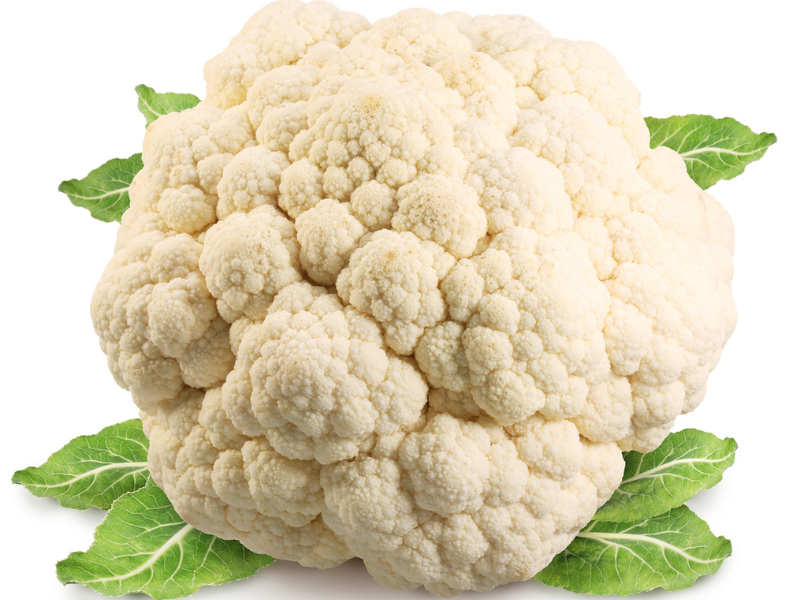
Early White Hybrid
For a strong and fast-growing cauliflower type, consider the Early White Hybrid. Early white hybrid cauliflower makes up for its lack of color with size and flexibility.
The extra-large white head grows to 9 inches and is surrounded by jagged jade leaves that grip the curd as it grows.
Description
This cauliflower itself may reach an astonishing height of 30 inches and may mature in as few as 52 days. It also exhibits higher cold tolerance than the average cauliflower.
This cultivar has the more classic cauliflower flavor and is great for grilling, roasting, sautéing, and crumbling into some rice.

Choose the best cauliflower for you
Now that you have a better idea of the different types of cauliflower, you should now be able to distinguish and identify this vegetable properly.
Take the time to explore various cauliflower varieties. You can check your local supermarket and see which ones are available in your area.
With so many types of cauliflower, you surely will find the right one for you!
